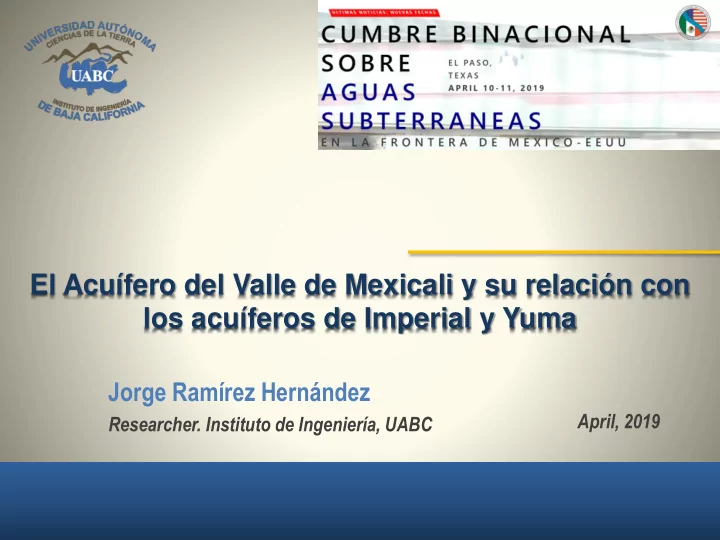

El Acuífero del Valle de Mexicali y su relación con los acuíferos de Imperial y Yuma Jorge Ramírez Hernández April, 2019 Researcher. Instituto de Ingeniería, UABC
Outline: • Something about Colorado River delta evolution • Colorado River flows, the water source • Mexicali, Imperial and Yuma aquifers • An integral groundwater system • Principal remarks
Colorado River Delta Aprox 800,000 hectars of wetlands Modified from Sykes, 1937
Colorado River Delta formation process • Deposits of marine sediments due to sea transgressions. • Continental sediment deposits from Colorado River. • Actual delta’s crest was probably constructed during middle Pliocene. • Divided the delta in two areas. – Salton basin to the north – Colorado delta to the south in connection with Gulf of California • Discharge to the Gulf but ocasionally veered to the northwest discharging to Salton basin (last time was at the begining of the XX century)
Data from The Colorado River at the Southerly International Boundary (USGS gage 09522200; 1950 – 2018)
Colorado River Hydrograph: natural vs controled flows
Colorado River Hydrograph: natural vs pulse flow 2014 Modified from Mueller et al, 2017
Colorado River Courses Modified from Mueller et al, 2017
1,200 1,100 1,000 Vol. Explotado (X10 6 m 3 /año) 900 Extracted Volume 800 (X10 6 m 3 /año) 700 600 500 400 4.00 Prof. Nivel Estático (m) 5.00 6.00 Groundwater depth(m) 7.00 8.00 9.00 10.00 11.00 Colorado (X10 6 m 3 /año) Colorado River 20,000 Escurrimientos Río discharge (X10 6 15,000 m 3 /año) 10,000 5,000 0 1955 1960 1965 1970 1975 1980 1985 1990 1995 2000 Tiempo (años) From Ramirez-Hernández, 2004
Valle de Mexicali aquifer Groundwater level contours for 1972 Black dashed = measured red = modelled Taken from Rodríguez-Burgueño, 2012
Aquifer wells field Source: CONAGUA Wells location Taken from Rodríguez-Burgueño, 2012
Valle de Mexicali and Yuma aquifers Groundwater level contour composition with data from: Lesser, 2006 USBR, 2015 Taken from Kennedy, Rodriguez-Burgueño and Ramírez-Hernández, 2017
Groundwater Drawdown along CR Modified from Ramírez-Hernández et al., 2018 •
Imperial aquifer Imperial ,1960-1965 before AAC and Coachella canal lining IID (2002)
Yuma aquifer 90% of water is producing in the upper basin section. From Yuma, 1965 from Olmsted et al. (1973) 0
Delta Geohidrological System Water level countors composition: Coachella Valley from Swain (1978) Imperial ,1960-1965 before AAC and Coachella canal lining IID (2002) Yuma, 1965 from Olmsted et al. (1973) Mexicali, 1972 from Díaz-Cabrera (2001) Taken from Ramírez-Hernández, 2019 under review. •
Recharge and extraction are dinamic in all the system Groundwater monitoring Water recharge = water extraction Aquifer sustainability
Principal remarks • Colorado river is no longer the water source • Recharge is due mainly because infiltration from irrigation channels, return of irrigation water and horizontal flows. • Efforts for reducing ag volumes because of pressure of others sectors (outside the basin) are reducing the recharge. • Water balance must define water exploitation politics in order to reach a sustainable use of water. • Actually there is no data to evaluate the recharge. • The delta groundwater system must be managed in a integrate way
BEFORE AFTER (March 23, 2014) (May 12, 2014) DURING Thanks… (March 27. 2014)
Aquifer actual situation • Water abstraction – Water pumping is not measured – SLRC valley increased volume • Water recharge – Vertical recharge is dimishing by channel linning (i.e. AAC) – Optimization of irrigation water volume – Water transfer out of the basin
Recommend
More recommend